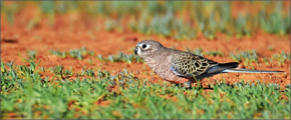





Bourke's Parrot
Description
Bourke's Parrot reach a body length of up to 22 cm and weigh around 40-50 grams. The relatively large eyes are striking. It is also possible to differentiate between the sexes of these birds without a DNA test, wild-colored cocks are brownish-pink and have wing and tail feathers colored blue to white. The bluish forehead is particularly striking, which is also referred to as a blue headband, and the pink belly. The color of the hens is very dull and they lack the blue forehead. The females also usually have a smaller head and beak. There are now various mutations such as Opaline, Edged, Blue, Turquoise, etc.Habitat
Bourke's Parrots come from Australia. There they colonize the dry steppe shrub in the interior of Australia, in which mainly acacia plants grow. The plants ensure their survival in the event of a lack of grass seeds. Their native food therefore consists of grasses and plant seeds. They live there in groups of up to 30 birds, in the dry season they can form larger flocks and comprise groups of 100 conspecifics.Reproduction
The Bourke parrots reach sexual maturity at the age of just under one year. The parrots that breed in caves have their breeding phase from August to December. After a breeding phase of about 18 days, the young birds hatch from the average of 4-8 eggs and are reared in the nest for about 30 days. During this time, the cock takes over the feeding of the hen so that the hen can hatch the chicks without any problems. Sometimes, however, the cock also raises the young animals. Around five weeks later, the young Bourke parrots are independent and fly out. A second brood often takes place afterwards. The young birds initially have a plumage color similar to that of the hens and reach their final color after about six months. The life expectancy of the animals is around 10 to 12 years.
Bourke‘s Parrot
Neopsephotus bourkii

© MB design - 2020 - www.mb-design.ch








© MB design - 2020 - www.mb-design.ch
Bourk‘s Parrot
Neopsephotus bourkii


























